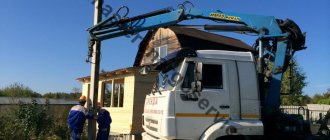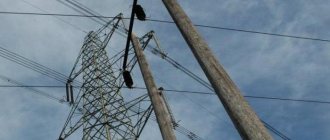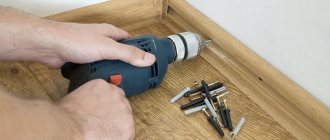- 1 Areas of application
- 2 Benefits of use
- 3 Materials used
- 4 How are they labeled?
- 5 Installation in the ground
- 6 Storage and transportation
The construction of extensive systems of electrical networks, overhead telephone and telegraph communication lines at one time required designers to develop reliable, durable supports, the installation of which would meet economic feasibility. Today, reinforced concrete products such as an attachment (the product is also called a stepson) are widely used for these purposes.
Areas of application
The series of reinforced concrete products, within which PT 33 (33-3, 33-4), as well as 43-2 were developed, was created by order of the Soviet relevant ministry. The project was completed in 1987, and in 1988, after passing all the necessary approvals, it was approved.
Now these trapezoidal products have become widespread, serving as supports for power lines (voltage from 0.38 to 35 kilovolts), telephone lines, and other types of cable communications. They are also used to lengthen pillars when arranging intersections and strengthening wooden posts.
Thus, a product with index PT 43-2, for example, has such characteristics as frost resistance (up to -55 °C) and strength. It does not absorb moisture and can withstand a magnitude 9 earthquake and strong wind pressure.
Return to contents
About impregnation of wooden supportsThe main condition when impregnating wood for overhead line supports is that these supports are installed directly into the ground, without reinforced concrete attachments, the so-called stepchildren. When connecting the wooden part of a support with a reinforced concrete stepchild using a wire bandage, the impregnation layer in the bandage area is grossly broken, the wood splits and this place is subjected to intense rotting, which leads to premature damage to the supports.
The main impregnated part in wooden racks is the outer side surface and end parts. The side surface of the pine (as the most resistant to wood decay) post should be impregnated to at least 85% of the thickness of the sapwood part (30-40 mm). The end parts of the racks are impregnated to a greater depth.
However, during operation, about 10% of the impregnating composition can be washed out of the rack through the side surface, and about 90% through the end surfaces. Therefore, when installing a wooden support, the upper end must be covered with a roof (in the ISS, the racks are covered with galvanized sheet steel measuring 250x250 mm), and the lower end must be covered with a flat moisture-proof material.
According to the requirements of GOST 20022.0-93, put into effect on January 1, 1995, pine wood for overhead line supports, impregnated by the vacuum-pressure-vacuum (VDV) method, must have an absorption of 13-15 kg of dry salt (powder) of a protective agent type XM- 11 per 1 m3 of impregnated wood. The average service life of such supports should be 40-45 years.
But Russian enterprises are going their own way. For example, the technical specifications TU 5314-001-00109671-2002 for the impregnation of logs for poles at the Vladimir Electromechanical Plant OJSC determine that the absorption of the drug in terms of dry salt must be at least 7 kg per 1 m3 of impregnated wood. The service life of the supports is set at 20-25 years. At the same time, at the time of development of the technical specifications, GOST 20022.0-93 was not canceled by any regulatory documents and these specifications were drawn up contrary to the requirements of GOST.
Another manufacturer of wooden racks states that the service life of reinforced concrete supports is 25 years, and wooden ones - 40 years. And at the same time he recommends installing supports on reinforced concrete stepsons. Then why do we need poles with a service life of 40 years if the attachment will only last 25 years? By the way, a reinforced concrete attachment has a smaller breaking moment than a stand made of the same material, and it will last even less.
One of the manufacturers of wooden poles, Lesenergoprom LLC, states that the BM-302 drilling and crane machine is able to transport several wooden poles on its own. My personal opinion: is it really possible to openly call for gross violations? It is impossible to carry out such transportation technically competently, because The design of the BM-302 does not provide for transportation of even the shortest (6.5 m) racks.
With all that has been said, I believe that if manufacturers of wooden racks find opportunities to provide high-quality impregnation, then the use of this material at Mosenergo can be resumed.
Let's consider the advantages and disadvantages of supports made of various materials for overhead lines with a voltage of 0.4-10 kV.
Reinforced concrete supports
Advantages: +
+ only one thing – manufacturability.
Flaws: -
– to transport racks by road from the manufacturer’s premises to their installation sites, special semi-trailers with a length of up to 12 meters are required. Unfortunately, currently, racks are transported on flatbed vehicles with a spreader trailer, which is designed to transport metal pipes or other non-fragile materials, but not reinforced concrete supports;
– when delivering to pickets during new construction or selectively replacing supports during major repairs, a truck crane is required to unload the supports individually or install the racks from the support truck directly into the pits;
– difficulty in dismantling reinforced concrete supports. Even if the management of RAO UES of Russia (which is unlikely) obtains permission from Gosgortekhnadzor to pull out reinforced concrete supports as a pinched indeterminate load, performing such work will be very labor-intensive and dangerous. Of course, you can break the support near the surface of the earth - this is not difficult; with a good push, the support will fall under its own weight. What's next? Then, in almost every electrical installation, a rather complex installation is required to destroy the rack and release the metal frame made of high-strength alloy steel. But even in this case, problems will arise: the metal can be re-melted, but dealing with concrete fragments will be very difficult. Asphalt plants, I think, will refuse them, because... on the roads they will damage car tires with their sharp corners. Complete disposal will become quite expensive;
- maintenance personnel of electric grid enterprises work with great fear on lines with reinforced concrete supports, and not without reason - there are frequent cases of installers falling off the top of the support.
Wooden supports
+ Benefits:
+ ease of maintenance – the electrician can easily and safely climb onto and off the support;
+ greater mechanical strength when exposed to natural phenomena (gusty winds, ice);
+ do not require careful handling (within acceptable limits, of course) during transportation, unloading, storage, installation in pits;
+ if it is necessary to deliver supports in emergency situations or if it is impossible to access the installation site, loading, unloading and installation of supports is carried out manually;
+ to increase service life, additional antiseptic treatment can be performed in places subject to more intense decay;
+ a large number of supports when transported by car (up to 60 pieces per trip);
+ ease of disposal;
+ wood is a renewable natural material that harmonizes well with the natural environment;
+ supports impregnated with antiseptic (without violating the technological cycle and technical conditions) can serve for 40 years or more;
+ low cost compared to reinforced concrete racks.
- Flaws:
– presence of harmful substances in the air of the working area. The degree of hazard depends on the impregnating composition and can be from hazard class 1 to 4 (example: gasoline and kerosene belong to class 4);
– when preparing logs for racks, it is necessary to select the diameters and runoff (taper) to match the dimensions of the fitter’s claws;
– to obtain high-quality impregnation and the required service life of the support, winter felling (from December to March) and atmospheric pre-impregnation drying of logs under a canopy for at least 6 months are necessary. In this case, during the period of atmospheric drying, it is necessary to antisepticize the surface of the logs from damage by biological agents.
Metal supports
The use of metal supports is advisable only in small towns, in the areas of parks, schools, stadiums, with the use (in the absence of PUE prohibitions) self-supporting insulated wires.
The supports must be hot-dip galvanized. In this case, the underground part of the rack and 20-30 cm of the above-ground part must be additionally treated with waterproofing materials during installation. In addition, during transportation, each support must be transported in separate packaging to prevent damage to the zinc layer.
Instead of a conclusion
Having analyzed the GOST requirements for the protection of wood, as well as the experience of preserving wooden poles in foreign countries, the Moscow cable network of Mosenergo OJSC is searching for manufacturers who provide high-quality impregnation of wooden poles , which will allow them to be installed directly into the ground without a reinforced concrete attachment.
Source of information: Magazine "News of Electrical Technology", 2003, No. 6 (24)
Thus, the use of wooden poles (supports) impregnated with oil antiseptics meets the goals of increasing the durability and reliability of the functioning of electrical networks and power lines while simultaneously reducing their cost. All these facts were taken into account by RAO UES of Russia, which in its circular No. 11-02/1-05 dated 03.10.2001, as well as by order No. 218 “On the results of the meeting of the Scientific and Technical Council of RAO UES of Russia” dated 18.04. 2002, in order to increase the reliability of electrical distribution networks, recommended the massive use of wooden poles (supports) of a new generation for technical re-equipment, reconstruction and new construction.
Benefits of use
Methods for pairing wooden support posts with attachments (stepchildren): a), c) wooden, b) reinforced concrete.
These reinforced concrete products are, first of all, distinguished by their economic feasibility. The use of racks that are expensive to manufacture makes the project itself take a long time to pay off. Wooden poles deteriorate too quickly. That is why preference is now given to reinforced concrete attachments - products that can extend the service life of electrical supports by a decade or more, thereby reducing the cost of their maintenance.
Stepchildren series 33, 43-2 have excellent technical characteristics; their production, storage, and installation are regulated by GOSTs, which allows us to speak about the real reliability of the products.
The operation of consoles 33-3, 33-4, 43-2 is permissible virtually throughout the country. However, the acquisition of a batch requires clarification of the climatic region where they will be installed. The optimal selection of concrete and reinforcement parameters depends on this.
Return to contents
Carrying out quality control
During factory acceptance of products, attention is paid to the following parameters:
- Accuracy of geometric dimensions;
- Testing strength and resistance to cracking;
- Compliance with the standards for the thickness of the protective coating;
- External inspection of each specimen.
Deviations from the norm for reinforced concrete attachments for wooden supports are allowed in length no more than 10 mm, in width and cross-section 5 mm, in unevenness 10 mm. The concrete layer of the product cannot be less than 20 mm. The outer surface of reinforced concrete products cannot contain cracks wider than 0.05 mm, cavities wider than 5 mm, gouges and chippings wider than 3 mm.
Materials used
For the production of reinforced concrete attachments, heavy vibrating concrete (or several types of it) reinforced with steel reinforcement is used. The quality of each of the components used to prepare the concrete mixture (Portland cement, coarse aggregates, water) is regulated by a separate GOST. Gosstandart also defines the class and grade of steel reinforcement for PT reinforcement. In addition, it is specially treated to prevent rust.
The production process itself includes the following stages:
- preparation of fittings and forms;
- reinforcement;
- pouring forms with concrete;
- monitoring the concrete until it completely hardens (in particular, inspecting the surface for defects that can still be eliminated - excess depressions, sagging, depressions near the edges).
The geometry of reinforced concrete PTs with index 33, 43-2 must correspond to the design.
Return to contents
How are they labeled?
The code “PT” means trapezoidal prefix.
The markings of the stepsons (numbers and letters) contain information about the name of the reinforced concrete product, the length of the product in decimeters (the first number) and the maximum load that the structure can withstand - its load-bearing capacity (the number after the hyphen). So, the letter “cipher” PT just means a trapezoidal prefix.
Indelible marking is applied after the reinforced concrete product has completely hardened and has already been removed from the mold. According to the state standard, the signs are located in its middle part; a stamp confirming the passage of technical control can be found at the end of the stepson - this is acceptable.
Return to contents
Installation in the ground
Installation of attachments is carried out exclusively using special equipment. A reinforced concrete pillar is immersed in the ground using industrial vibrators, or it is pressed with a unit mounted on a tractor. A pile driver (pile driver) is not used: this can lead to destruction of the concrete base and exposure of reinforcement. If the installation of stepsons takes place in soft soil, they are reinforced with reinforced concrete or wooden support beams (crossbars). The base for mounting attachments can be either specially prepared or not.
Return to contents
Storage and transportation
Storage of reinforced concrete stepsons, according to the rules, is carried out in stacks, on wooden pads. The height of one such stack is no more than 4 rows (the attachments in each are selected according to the diameter); wood is also used between the rows as a spacer. According to standards, stacks must be protected from the sun.
Reinforced concrete attachments are transported, observing certain precautions. To avoid mechanical damage, the supports are loaded/unloaded using mechanical lifts or manually. In this case, the mounting loops must be secured in two places equidistant from. During such work, products should not be subjected to sharp shocks, jerks, impacts, or dropped.
The stepsons are delivered to their destination by transport adapted for such transportation; during the “trip” the elements, as during storage, are arranged with wooden spacers. The bottom row attachments must be of the same diameter. Place them tightly next to each other and tie them tightly.
Why do you need a reinforced concrete attachment?
A support with a reinforced concrete attachment is widely used in the construction of telephone and satellite communication lines. The construction of these systems required the designers to create a reliable and durable support, which later became an attachment called the “stepson”. Its production did not require large financial expenditures.
PR 0.6 attachment











